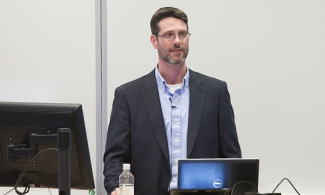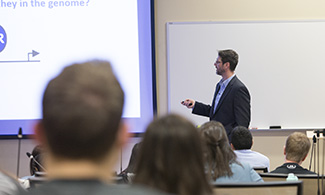Wednesday, April 12, 2017
Center for Research continues BFSS with research presentation on Alzheimer’s
Wed, 05 Apr 2017Asa Keimig | LUCOM Marketing and PR Coordinator

The Liberty University College of Osteopathic Medicine-Center for Research (CR) continued its Biomedical Frontiers Seminar Series (BFSS) last month, featuring Gary D. Isaacs, Jr., PhD, associate professor of Biology at Liberty University (LU). The BFSS welcomed over 65 guests from both LU and LUCOM that were interested in Dr. Isaacs presentation, “Bridging the Gap Between Epigenetic Alterations of the Genome and Disease Phenotypes.” Dr. Isaacs spent his lecture briefly walking everyone through his research on Alzheimer’s disease (AD) and the chemical modifications which alter a DNA sequence. His hypothesis is that such chemical modifications result in AD. He stressed the importance of genetic changes and why they matter and laid a foundation of his past research, present research, and future research.
Cell culture model system for studying AD
Dr. Isaacs has analyzed DNA methylation patterns using differential restriction enzymes (Hpall versus Mspl). The results of his research were that Methylation is not uniform. Methylation is the process by which methyl groups are added to a DNA molecule. It changes the activity of a DNA segment without changing the DNA sequence. Several lines of his evidence point to an epigenetic influence in AD development.
- The late onset of AD is sporadic in nature with no known cause.
- AD discordance in monozygotic twins suggest non-mendelian acquisition.
- Parent of origin effects have been described.
- DNA methylation changes have been associate with “AD twins.”
- Even well-known AD genes are known to be regulated by methylation.
Mouse model system for studying AD
Dr. Isaacs received transgenic mice from Jackson Lab carrying the amyloid precursor protein (APP) and presenilin protein (PSEN1). Through his research, he is able to analyze messenger ribonucleic acid (mRNA) patterns using a RNA sequencing (RNA-seq) procedure. He looks at disease as it is caused by DNA, something had to have happened to the cell which then altered it.
His focus is on several genes for confirmation of:
- Pathway involved in AD
- Genes not so well studied/known
- Non-coding RNAs
He is interested in studying the nutritional model and wants to manipulate DNA methylation in mice through diet and observe the outcome (behavior, genome methylation, gene expression).
Nutritional model system for studying AD
Dr. Isaacs’ goal is to determine the activity of genes in both brain tissue and also in blood. He created a model that could mimic AD and studied pregnant female mice and their nutrition through multiple tests and multiple tissue samples. Within 4 months, he and his team were able to see a behavioral difference in the mice, indicating that genes had been altered in learning. They are now working to develop a screening process.
 Dr. Isaacs had his first experience of teaching, when he was offered a job as a high school biology teacher while he was being wait listed for medical school. At the time, he accepted, but made it clear that when he got the call, he was gone. He started teaching science and fell in love with it. It was then, for the first time in his life, he realized what his God given talents were and how to use them in a unique way. “God doesn’t care what you do, but He cares about who you are,” said Dr. Isaacs. “If you have a heart that follows him, it all falls into place.” He went through six years of graduate school with three children, and for him it was hard. “It kicked my rear-end, but I joined because it was tough,” said Dr. Isaacs. “I believe God had me go through the toughness, because I wanted to teach students, and how can I give good advice if I don’t know what it’s like.”
Dr. Isaacs had his first experience of teaching, when he was offered a job as a high school biology teacher while he was being wait listed for medical school. At the time, he accepted, but made it clear that when he got the call, he was gone. He started teaching science and fell in love with it. It was then, for the first time in his life, he realized what his God given talents were and how to use them in a unique way. “God doesn’t care what you do, but He cares about who you are,” said Dr. Isaacs. “If you have a heart that follows him, it all falls into place.” He went through six years of graduate school with three children, and for him it was hard. “It kicked my rear-end, but I joined because it was tough,” said Dr. Isaacs. “I believe God had me go through the toughness, because I wanted to teach students, and how can I give good advice if I don’t know what it’s like.”
Dr. Isaacs received his BS from Liberty University and his PhD from Cornell University. He teaches classes in genetics, independent research, and human genetics and his current research interests are in the gene regulation in eukaryotes and various techniques using deoxyribonucleic acid (DNA) methodologies.